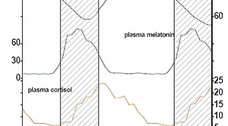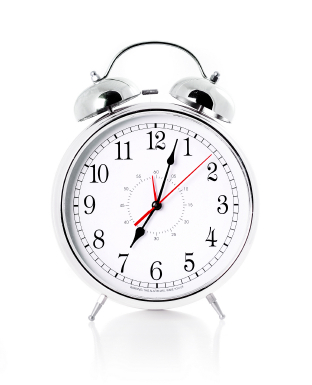A little history
Some of the first published evidence for circadian rhythms came from studies in plants. In 1729, the scientist Jean-Jacques d'Ortous de Mairan conducted a simple experiment: by keeping a plant in a dark environment, he observed that the characteristic day and night opening and closing of the leaves would persist—even though the plant was constantly away from the sun.
It had previously been assumed that environmental light and darkness throughout the day caused these movements. However, this experiment demonstrated that it takes something other than the plant's environment—perhaps something internal to the plant— to explain this phenomenon.
24 hour cycles
The word, circadian, comes from the Latin terms, circā (about) and dies (day). Today, the term is used to signify biological events that predictably reoccur once every 24 hours.

Early studies found that humans isolated for several weeks from the 24-hour light/dark cycle still maintained a cycle of alternating rest (sleep) and activity (wake) that approximated 24 hours. The persistence of this so-called sleep/wake cycle, even in the absence of daily changes in the environment, suggests that humans have an internal biological clock that modulates behaviour.
For this reason, circadian rhythms are referred to as endogenous, meaning they are generated within our bodies by an internal timing mechanism: a circadian clock. In humans, circadian rhythms are observed in the normal variations in:
- the body temperature
- the hormones (cortisol, melatonin)
- the heart rate
- the alertness
- the mood
- the vigilance
- the memory
Influence of circadian rhythms on the body
Almost every aspect of physiology is affected by circadian rhythms including:
Sleep/Wake cycles
The periodic alternation of sleep and waking is one of the most easily observed daily rhythms. In normal individuals who are active and working during the day, two processes interact to keep them awake for approximately 16 hours and asleep for approximately 8 hours:
- a homeostatic process: keeps track of the need to sleep, increasing the pressure to sleep as one stays awake longer. In other words, the longer you've been awake, the greater the desire to sleep
- a circadian clock process: provides strong physiological signals favouring sleep or waking at specific times of day. This means that certain times of day are better for sleep than others
In a practical sense, the interaction of these two processes can explain why many night shift workers have problems sleeping enough in the day despite having been awake for 16 hours or more. Going to sleep at times when the circadian pacemaker favours waking are inappropriate and can result in shorter or more fragmented sleep episodes.
Age
From childhood to old age, the circadian pacemaker changes, affecting the changes in sleep habits that occur in our lives. In response to the signals from their circadian clocks, adolescents may prefer to go to bed and wake up later. With advancing age the opposite occurs: bed and wake times are earlier while sleep becomes lighter. Interestingly, laboratory animals bred with mutations in the genes of the circadian clock can demonstrate not only altered circadian rhythms but also signs of premature ageing.
Body temperature
Core body temperature also follows a definite circadian rhythm: in the late afternoon, temperature can be one degree Celsius higher than in the morning. In fact, the regulation of heat loss throughout the body follows a circadian rhythm which is closely associated with sleep and sleepiness.
At bedtime, body temperature sensors can detect a gradual decline in core body temperature and an increase in temperature at the extremities (i.e. hands and feet) which are closely associated with the initiation of sleep. Maximal levels of sleepiness, normally reported in the pre-dawn hours, occur at the same time as the minimum in core body temperature.
Hormone production
Some hormones are more closely associated with circadian rhythms than others. Melatonin shows a strong circadian rhythm, which typically peaks during the night. Cortisol affects many body functions, including metabolism and regulation of the immune system. Its levels are highest in the morning and gradually decline throughout the day to reach its nadir early in the night.
Cardiovascular system
More strokes and heart attacks occur in the morning than at any other time of day. Blood pressure also rises in the morning and stays elevated until late afternoon; it then continues to drop hitting the lowest point during the night.
Pain tolerance
Pain tolerance is highest in the afternoon - for example, tooth pain appears lowest in the late afternoon.
Menstrual cycle
Women report changes in their sleep throughout the menstrual cycle with more sleep disturbances occurring just before menstruation. In fact, disturbed sleep is one of the diagnostic criteria for the Premenstrual Dysphoric Disorder (PMDD). Interestingly, changes in the circadian rhythm of core body temperature are also known to occur across the menstrual cycle, and a disruption of the circadian rhythm of melatonin production is associated with PMDD. This has prompted scientists to further investigate the biological basis for these changes and the relationship between the circadian clock and the menstrual cycle.
Medication
Scientists are looking at how circadian rhythms affect the way the body uses medications. One finding is that less anesthesia is needed to cause drowsiness when administered in the afternoon. Circadian rhythms in the function of individual tissues means that a drug administered in the same formulation and dose can have vastly different effects when it is administered at different times of day. Thus, chronotherapy harmonizes treatment with endogenous circadian rhythms in order to achieve maximal efficacy. For example:
-
Blood pressure medication: The important changes in heart rate and blood pressure that occur around the time of awakening could in part account for the increase risk of heart attack or stroke in the morning. Medication taken at bedtime, is released into the bloodstream hours later, and is most effective during the early morning hours, when blood pressure and heart rate rise most precipitously. As pressure drops in the evening, the concentration of the drug also wanes.
-
Cancer treatment: The application of chronotherapy to chemotherapy in the treatment of cancer seeks to deliver drugs at times of maximal tolerability and efficacy and minimal toxicity.
-
Other conditions such as asthma, hay fever, and rheumatoid arthritis may also be effectively treated with chronotherapy.
This content was developped by Diane Boivin, MD, PhD, director of the Centre for Study and Treatment of Circadian Rhythms.
[Circadian Rhythms: what are they?] [Circadian Rhythms: the effect of the light] [Circadian Rhythm Disorders] [Circadian rhythms disorders: a few tips]



